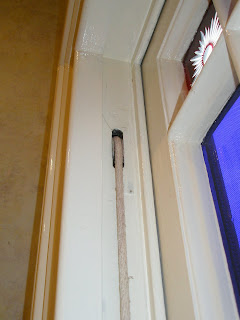High on my list of regular requests are problems with windows and after dealing with quite a number this week I felt a small piece outlining their problems and solutions may be in order; I’ll also throw in a little history. Whilst the focus is on timber, the points made here can be readily applied to both steel and aluminium and covers all styles.
Overwhelmingly, window problems are preventable and due in the majority of cases to one thing - poor maintenance. I cannot stress this enough to owners and tenants alike and I will repeat here what I regularly say to all with window problems. The key to sound and functioning windows is down to two words of one syllable each, if you have windows ‘USE THEM’.
Too simple you say?
Trust me I know what I’m talking about because I see the same problems almost every week and am called in to fix what was easily preventable. How many of you open your widows on a regular basis? Do you have a room where the windows are never used? Certainly you do, we all do and that is the problem. A window sash is simply any timber or metal framed moving glass panel. Whether the window is a traditional vertical lifting sash, a side hinged casement or a top hinged awning variety, excessive moisture retention leads to serious consequences. I’ll save my attitudes to our growing obsession with air conditioning for another time but consider this, if the inside temperature is vastly different to the outside, then timber (particularly) is prone to distortion.
Moisture invariably gets trapped between the sill (the very base of the window) and the bottom of the sash and quietly rots away whilst the unwary occupant basks in sub tropical heat. Add to this scenario the successive layers of paint applied to the interior more than the exterior and you begin to understand the dilemma. One recent owner was perplexed about his rotting Bathroom window, “...after all John, we never, ever open it so why is there a problem?”
Traditional Weighted Sash windows
The moving, timber framed, glazed sash immerged in the early seventeenth century and is generally attributed to the French. It was the English however who perfected the counter balance mechanism that allows the vertical sliding sash to be self-supporting when moved and this weight-balanced system dates from around 1680. The rope sash window typically seen in Victorian and Edwardian houses is essentially unchanged from the seventeenth century design and almost 350 years of regular use must surely say something about reliability.
Replacing the broken or worn sash ropes is one of my most rewarding maintenance jobs as it gives the resident a functioning window and in all probability a repair that lasts for decades. If you have broken or frayed ropes it is relatively simple to have them replaced but please do so before you paint the windows as access to concealed weights does require removal of some of the timber trims (not as frightening as you imagine).
I was once directed by an estate agent to cut off the broken cords of a sash window and nail it shut. Incredulous at his barbarism you can imagine my answer.
As indicated, a window regularly used will avoid rot but if it exists and continues unchecked a wooden sash or sill will become severely damaged. This process of damage is not quick and is the result of years of neglect and indifference. When a sash itself is weakened by rot, the joinery naturally loosens, making the glass precarious. The simplest solution is to replace the whole sash frame itself with a salvaged one of the same size. If a replacement cannot be readily found another option is to partially remake the frame, replacing damaged timbers (usually the base) with new sound timbers. Once painted the replacement lengths are virtually undetectable. The downside here is time, for the offending sash must be left with the joiner (usually a week) leaving the occupant with a missing windowpane.
So to avoid all this you need to go right now and open those windows you’ve been neglecting. What’s that? You can’t open them? Nailed shut? Rotting? Broken cords?
Relax, it’s ok you can give me a call. Just don’t ask me to nail them shut.
 |
 |
| Sad yet extremely common examples of neglect. Obviously these window frames and sashes are beyond repair and will need to be replaced. An easily avoided expense. |
 |
A severely damaged sill from a 1902 Edwardian house, caught at this point irrepairable damage can still be avoided. |
 |
| Another window from the same premises. Note earlier attempts to replace rot in the sash frame with epoxy filler. A full sash replacement is the only solution for this problem. |
 |
| Detail of a well maintained Victorian window showing the rope and traditional pulley mechanism. |
